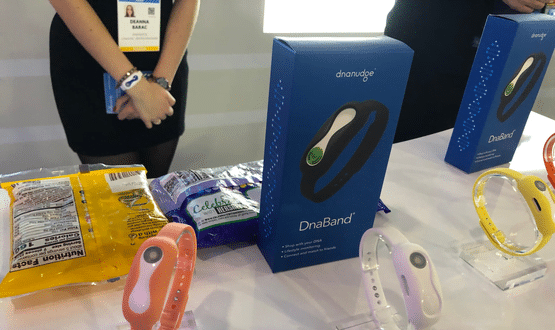Emerging tech and trends to watch from CES 2020

CES 2020 attracted around 170,000 people with more than 20,000 products making their debut. Lindsey Birnsteel writes about the most exciting healthcare technologies which emerged from the show and trends to look out for.
Techies will say that “every company needs to be a tech company” and CES 2020 has proven yet again why companies across nearly all vectors with the latest, most sought-after technology have enabled them to become market disruptors and leaders.
Digital Health News has been covering the show over the past week and now we give you the most exciting emerging technologies and trends to look out for in 2020 and beyond.
Digital health and wellness technologies are taking social determinants seriously
CES saw a number of technologies that are truly taking a more holistic approach to health and wellness.
Florida-based CarePredict, has brought to market the world’s first wearable for seniors that autonomously observes changes in their daily activity and behavior patterns. Its product CarePredict Tempo, a CES 2020 Innovation Awards Honoree, consists of a wearable for the senior, context beacons for location insights and an end user app designed for the caregiver.
Rather than assessing physiological measurements, CarePredict Tempo uses artificial intelligence (AI) and machine learning (ML) to predict possible malnutrition, depression, mild cognitive impairments, and increased risk of falling. Smart algorithms are used to correlate increased night waking with greater likelihood of falling as well as more frequent bathroom visits with a heightened risk of urinary tract infections. It also flags self-care neglect, such as showering less, as an indicator for depression.
CarePredict is disrupting the senior care space and creating a paradigm shift from detect and treat to predict and prevent through their wearable and smartphone app.
AI-powered devices and sensors are nudging consumers to make healthier choices
CES 2020 saw a surge in digital health technologies that are changing the health and wellness landscape by arming the user with information that goes beyond the physiological realm and into the environmental, social and behavioral. This timely, personalised data is empowering the consumer to make healthier choices.
The top two killers are cancer and cardiovascular disease and the US has the worst preventative mortality rate than any other developed country. The digital health industry is set to tackle preventative driven outcomes by changing consumer behavior.
At CES the BreezoMeter was touted to provide “data that actually drives change”. The Israeli company’s technology delivers actionable and personalised information to companies and individuals around the world using its 440 million virtual air quality sensors combined with a personalised assistant in your smartphone.
Using advanced algorithms and ML, the company generates hyper local environment data and drives users to take action. User groups that would particularly benefit from the technology are the elderly, children and those with chronic conditions such as asthma and COPD – both conditions known to be agitated by pollution.
Breezometer generates the data and sells the algorithm across a number of verticals, including smart homes and IoT, healthcare and wellness, cosmetics and skincare, smart city, automotive and smart mobility and media and advertising.
Suggestic, based in San Francisco, is an AI-powered personalised health and wellness technology that aims to nudge users to make healthy eating decisions at home and on the go. By incorporating a personal assessment, lab tests (such as food sensitivity), diet preferences and restrictions, Suggestic will suggest a healthy meal plan, grocery list and recipes.
The most interesting aspect of this product is the Suggestic Lens, an augmented reality (AR) feature whereby the user simply points the smartphone to any restaurant menu and can instantly see an overlay of what would be a healthy choice based on diet, biology, preferences and goals.
Telemedicine is finally being put into the hands of the consumer
The consumerisation of telemedicine has been a long time coming. The predicted spike in inpatient visit consultants in the US has finally spurred advancements in telemedicine that may actually prove to be impactful.
The industry is continuing to shift towards a consumer-centric view of healthcare to improve health outcomes. No longer is telemedicine primarily targeting gaps in the quality of care and access in rural areas.
California-based MedWand Solutions has developed a telemedicine tool for the patient that houses multiple diagnostic tools in a single, easy to use handheld device. With the patient in control, clinicians can conduct remote office visits by collecting multiple vital signs in real time.
MedWand allows the doctor to remotely listen to the heart, measure heart rate and conduct an ECG. It can also listen to lungs and measure respiratory rate, measure blood oxygen levels, take temperature readings and listen to the abdomen. And if that wasn’t enough, it can look inside a patient’s ear, nose, throat, and mouth as well as inspect skin.
MedWand has telemedicine applications in military support operations, home healthcare, EMS, hospice and palliative care and assisted living environments.
Neofect had a lively booth showcasing a suite of smart rehabilitation solutions for stroke patients. Every 40 seconds someone in the US has a stroke, and 500,000 people will seek rehabilitation services to minimize the damage caused by a stroke and improve wellbeing each year.
Neofect’s unique selling point is the gamification of rehab – making the rehab process fun and engaging. This San Francisco company’s suite of products include Smart Balance, Smart Glove as well as its newly launched Neofect Connect, a standalone companion app for stroke recovery.
Physical and occupational therapists can connect with users through the app to guide patients through rehabilitation remotely, regardless if they are using any of its products.
Digital health devices as a drug free alternative
As the US continues to struggle with the opioid epidemic, more and more smart technologies are being pushed to market to provide drug free solutions. America’s love affair with prescription medicine is thankfully being disrupted by digital health.
Boston-based Tivic Health Systems has developed a game-changing treatment for sinus pain due to allergies called ClearUp Sinus Pain Relief. This small, handheld device is the first to use gentle microcurrent waveforms to reduce allergy-related sinus pain. With 40 to 60 million Americans suffering from allergic rhinitis, this drug-free, non-invasive device is available without a prescription for $149 (£114) and is sold on Amazon.
With an overarching theme of putting technology into the hands of the consumer to prevent and change, this year’s digital health technologies are aiming to further disrupt the industry and drive investments into those use cases that address the most pressing health issues of today.



